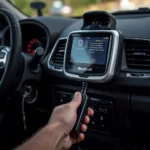Modern vehicles are heavily reliant on sophisticated electronic systems for optimal performance. When issues arise, accurate car information for diagnostic purposes is crucial for efficient troubleshooting and repair. This comprehensive guide delves into the importance of obtaining the right car info for diagnostics, explores various sources of information, and highlights key data points to look for.
Why is Car Info Crucial for Diagnostics?
Gone are the days of relying solely on mechanical expertise to fix cars. Today’s vehicles are complex machines with intricate networks of sensors, modules, and electronic control units (ECUs). When a fault occurs, it triggers specific Diagnostic Trouble Codes (DTCs) stored in the vehicle’s computer system. These codes act as a starting point for diagnosis, but they often require further interpretation and contextual information to pinpoint the root cause.
This is where accurate and detailed car info becomes indispensable.
Types of Car Info for Diagnostic
Effective diagnosis relies on gathering information from several key areas:
1. Vehicle Identification:
- VIN (Vehicle Identification Number): This unique 17-character code provides essential details about the vehicle’s make, model, year, engine type, transmission, and manufacturing plant.
- Year, Make, and Model: This basic information helps determine the correct diagnostic procedures, wiring diagrams, and technical specifications for the specific vehicle.
2. Symptoms and Fault Codes:
- Customer Description: Gathering a detailed description of the symptoms from the vehicle owner is often the first step. Information such as when the problem occurs, any unusual noises, warning lights on the dashboard, and recent repairs can provide valuable clues.
- DTCs (Diagnostic Trouble Codes): These codes indicate specific areas where the vehicle’s onboard computer system has detected a malfunction. Retrieving and understanding these codes is essential for effective diagnosis.
3. Vehicle History:
- Service History: Previous repairs, maintenance records, and parts replacements can shed light on recurring issues and potential causes of current problems.
- Accident History: Previous accidents can sometimes lead to hidden damage that can manifest as electrical or mechanical issues later on.
4. Technical Specifications:
- Wiring Diagrams: These visual representations of the vehicle’s electrical system are crucial for tracing circuits, identifying components, and understanding how they interact.
- Component Locations: Knowing the exact location of sensors, actuators, and other components within the vehicle saves time and ensures accurate testing and repairs.
- Technical Service Bulletins (TSBs): Manufacturers issue TSBs to address known issues, provide updated repair procedures, or announce recalls. Checking for relevant TSBs for the specific vehicle and its symptoms can be invaluable.
Sources of Car Info for Diagnostic
1. Onboard Diagnostic Systems:
- OBD-II Port: Most vehicles manufactured after 1996 have a standardized OBD-II port that allows access to diagnostic trouble codes and real-time data from the vehicle’s ECUs.
- Scan Tools: Various types of scan tools, from basic code readers to advanced professional-grade devices, can connect to the OBD-II port to retrieve and interpret diagnostic information.
2. Online Databases and Software:
- Manufacturer Websites: Car manufacturers often provide online resources for technicians, including access to service manuals, wiring diagrams, and technical bulletins.
- Third-Party Databases: Several online platforms specialize in providing comprehensive vehicle information, including repair guides, DTC libraries, and technical specifications.
- Diagnostic Software: Sophisticated software applications are available that offer advanced diagnostic capabilities, including live data streaming, actuator tests, and module programming.
Tips for Utilizing Car Info Effectively
- Accurate Information is Key: Ensure the information gathered is accurate and relevant to the specific vehicle being diagnosed. Using incorrect data can lead to misdiagnosis and unnecessary repairs.
- Understand the Context: Don’t just focus on the symptoms or fault codes in isolation. Consider the vehicle’s history, operating conditions, and any recent repairs to get a complete picture.
- Utilize Multiple Sources: Cross-reference information from different sources to verify accuracy and gain a more comprehensive understanding of the problem.
- Stay Updated: The automotive industry is constantly evolving. Keeping up-to-date with the latest technologies, diagnostic procedures, and information sources is crucial for effective car diagnostics.
Conclusion
Accurate and comprehensive car information for diagnostic purposes is the foundation of efficient vehicle repair. By understanding the types of information needed, knowing where to find it, and using it effectively, technicians can accurately diagnose and resolve even the most complex automotive issues, ensuring vehicles are back on the road safely and reliably.
Need assistance with your car diagnosis? Contact us via WhatsApp: +1(641)206-8880, Email: cardiagtechworkshop@gmail.com. Our team is available 24/7 to offer support.


